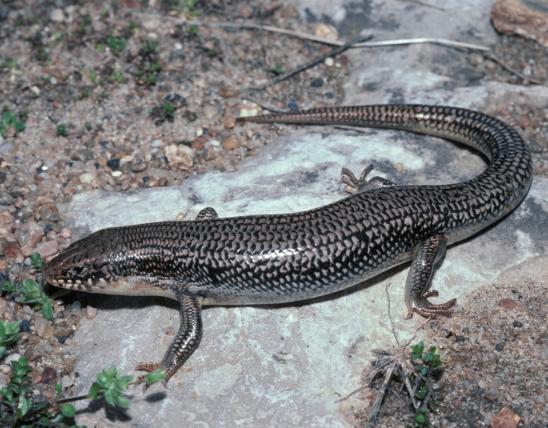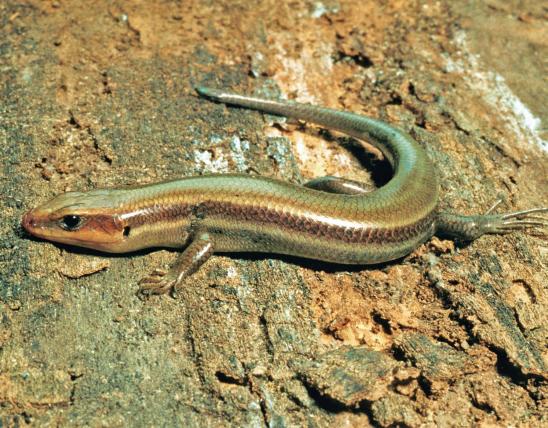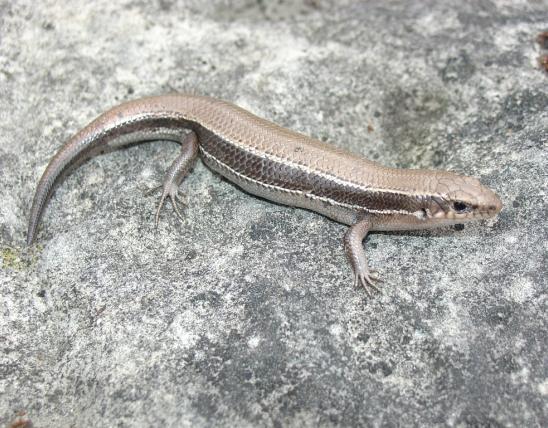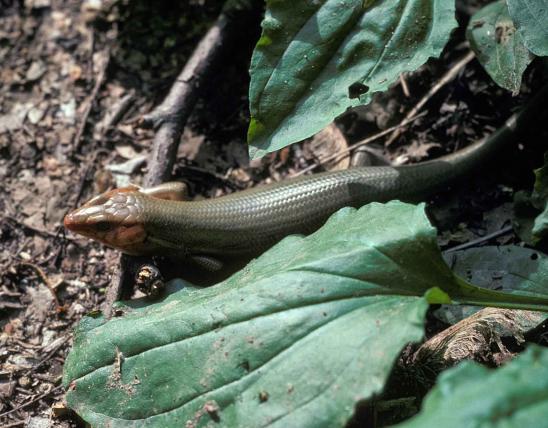
Prairie skinks are lizards with many stripes and a long tail. There are two subspecies in our state, and they look quite similar. Their ranges do not overlap. In general, these skinks have a longer tail than all other Missouri skinks. The ground color is tan to olive brown.
- Of our two subspecies, the northern prairie skink (Plestiodon septentrionalis septentrionalis) is more common in Missouri, being found in several northwestern counties. Along its back and extending onto the tail, there is a narrow, light line with a prominent dark stripe on each side. There are additional thin dark stripes along the sides of the body. During the breeding season, males have reddish orange on the head; females do not have this coloration. The young are darker than the adults, and they have a bright blue tail.
- The southern prairie skink (Plestiodon septentrionalis obtusirostris) is rarer in Missouri and so far is known only from Barton County, along the Kansas border, well to the south of known populations of the northern prairie skink. The northern prairie skink has more dark striping along the body and tail than the slightly smaller southern prairie skink, whose stripes are fewer or fainter. The widest line along the side is only 2 scales wide.
Adult total length: about 5–9 inches (northern prairie skink). Southern prairie skinks are smaller, about 5–8 inches.
Northern prairie skinks live in several northwestern Missouri counties. The southern prairie skink is known from Barton County, in southwestern Missouri.
Habitat and Conservation
Prairie skinks are mainly active from April to September, with peak activity in April into June.
The preferred habitat is native prairies and open grasslands with flat rocks or similar shelters near small streams, marshes, lakes, and ponds. Prairie skinks spend much of their time under rocks or in grass thatch. They sun for short periods during the morning or early afternoon.
Prairie skinks will quickly run under rocks, into thick vegetation, or into water to escape a predator.
Prairie skinks overwinter in burrows excavated by themselves or other small animals.
These lizards require native prairie habitat in order to survive
Food
Prairie skinks eat a variety of insects, such as grasshoppers, crickets, beetles, and caterpillars, plus spiders, snails, and young lizards.
Status
Both prairie skink subspecies are rare in Missouri and are listed as species of conservation concern. Like many organisms that can only live on native prairie, this lizard is declining due to degradation, loss, and fragmentation of habitat. Much of our native prairie was lost years ago when it was plowed and converted into crop fields.
Until 1992, only one record — from 1949 — had existed for the northern prairie skink subspecies in Missouri. In 1992, researchers found numerous individuals in a remnant native prairie in Harrison County, but records still remain scarce in the state. Missouri’s populations of northern prairie skink represent the far southeastern edge of its overall North American range.
The southern prairie skink subspecies was first reported in Missouri in April 1992, in Barton County. It remains the only known location for the southern prairie skink in Missouri. Missouri’s populations of southern prairie skink represent the far northeastern edge of its overall North American range.
Some scientists consider our two subspecies as fully distinct species. Once adequate geographic sampling and genetic testing is completed, these lizards may become accepted as different species.
Life Cycle
In Missouri, courtship and egg-laying likely occur in May and June. In middle to late June, the female lays 5–18 eggs in a moist, shallow burrow under rocks, logs, or boards. She remains with her eggs until they hatch, protecting them aggressively from predators and intruders. Eggs hatch in 1–2 months. As with many other skinks, the hatchlings have a bright blue tail. They reach sexual maturity in 2 years.
Human Connections
Often when we think of our interactions with animals, we focus on what they can do for us: Can we eat them? Or might they harm us? But when it comes to rare or declining species, the situation is reversed: Our human settlements and agriculture have eliminated most of their ancestral habitat; so what can we do for them? Often, it comes down to habitat conservation.
Ecosystem Connections
This species eats a variety of insects and spiders. Animals that prey on prairie skinks include snakes, hawks, badgers, skunks, and birds. Prairie skinks may be captured by loggerhead shrikes, as their bodies have been seen impaled on barbwire fences in the shrikes’ typical fashion.
Skinks can quickly break off their tails if grasped by a predator. This is an adaptation that can help them survive such encounters.
The skinks (Scincidae) are a large family of lizards with species on nearly every continent and many oceanic islands. There are over 1,580 species worldwide. Missouri has six species of skinks.






























